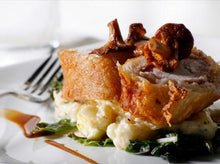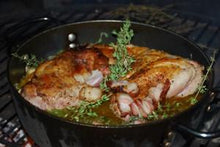Rabbit - A European Staple (Lapin)
Grande Premium Meats
Regular price
$ 117.95
Sale
Rabbit is the ultimate in sustainable meat. Rabbit is a lean, delicately-flavored meat with all the versatility of chicken. Rabbits are environmentally-friendly, easy to raise, and produce tender white meat that is considered the most nutritious protein by the USDA. When rabbit meat is on the menu, expect controversy to follow. It is socially acceptable to use farm animals, such as cows and chickens, as food; however, many people balk at the idea of eating rabbit. Despite this resistance to consuming rabbits, this lean meat serves as a healthful and nutritious alternative to beef and pork.
Rabbit Nutrition (from Livestrong.com, Nicki Wolf, 5/31/15)
Fat and Cholesterol
Rabbit meat is relatively low in fat; each 3-ounce serving has 6.8 grams of fat, which accounts for 37 percent of the calories. Compared to beef and pork, rabbit is the clear choice -- 3 ounces of beef has 18.3 grams, and 3 ounces of pork has 8.2 grams. Your meal plan should ideally contain 44 to 78 grams of fat per day, or 20 to 35 percent of your calories. Rabbit meat is low in saturated fat, as well, containing 2 grams. Consuming high amounts of saturated fat may put you at greater risk of coronary heart disease; you should limit your intake of these fats to 15 grams per day. A 3-ounce serving of rabbit meat contains 69.7 milligrams of cholesterol, a necessary substance in your body for cell formation. However, you do not need dietary cholesterol as your body produces all you need. Do not consume more than 300 milligrams of cholesterol per day to avoid health problems that can result from high cholesterol and if you suffer from heart disease, the American Heart Association recommends limiting your intake to just 200 milligrams daily.
Protein
Three ounces of roasted rabbit meat contributes toward your daily protein needs. This portion provides you with 24.7 grams of this macronutrients. Protein keeps your body working in myriad ways, from supplying your body with energy to helping your build muscles to maintaining the function of your immune system. The University of Illinois website notes that consuming a low protein may cause you to eat more food in a day as it affects how full you feel. The recommended amount of protein to ward off hunger ranges from 10 to 20 percent of your daily calories.
Vitamins
Adding rabbit meat to your meal plan gives you a big boost in vitamin B-12 -- each 3-ounces serving provides 117.6 percent of the recommended daily intake. Vitamin B-12 plays a critical role in the function of your central nervous system and metabolism, as well as the formation of red blood cells. Your body has the ability to store a few years' worth of vitamin B-12, so eating rabbit supplies you with not just your daily requirements, but a little extra as well. Rabbit also serves as a rich source of vitamin B-3, containing 35.8 percent of the amount your need each day. This vitamin, commonly known as niacin, aid in converting carbohydrates to energy and manufacturing a variety of sex hormones.
Minerals
Rabbit meat contains quite a bit of selenium, a mineral your body uses to make antioxidants and stimulate sperm production; each 3-ounce portion of meat contains 46.8 percent of the recommended daily value of selenium. MedlinePlus reports that some physicians may recommend incorporating more selenium into your diet to combat hardening of the arteries, as well as cancers such as stomach, lung, prostate and skin cancer. A 3-ounce serving of rabbit also provides you with 22.4 percent of the phosphorus you need in your daily meal plan. This mineral accounts for 1 percent of your total body weight and influences your body's ability to use carbohydrates and fats, as well as the repair of cells and tissues.
Cooking Rabbit
If you are cooking a young rabbit (8 to 12-weeks old), called a fryer, which will be more tender than the older roasters(15-20 weeks), you can fry or roast it. The roasters, contrary to their name, need slow, moist cooking, like braising. If you are cooking rabbit parts, try the saddle or loin, which are the most tender of the cuts. The front legs are tiny and are best to set aside for stock or stew. The hind legs are tough and almost always need a moist braise. Lean rabbit meat really begs for bacon, or ventreche, to add some fat and protect it during cooking. So don’t be shy with the duck fat, olive oil, or bacon.
Rich Forrest - Owner of Grande Premium Meats

Del Norte - Colorado
SaveSaveSave




